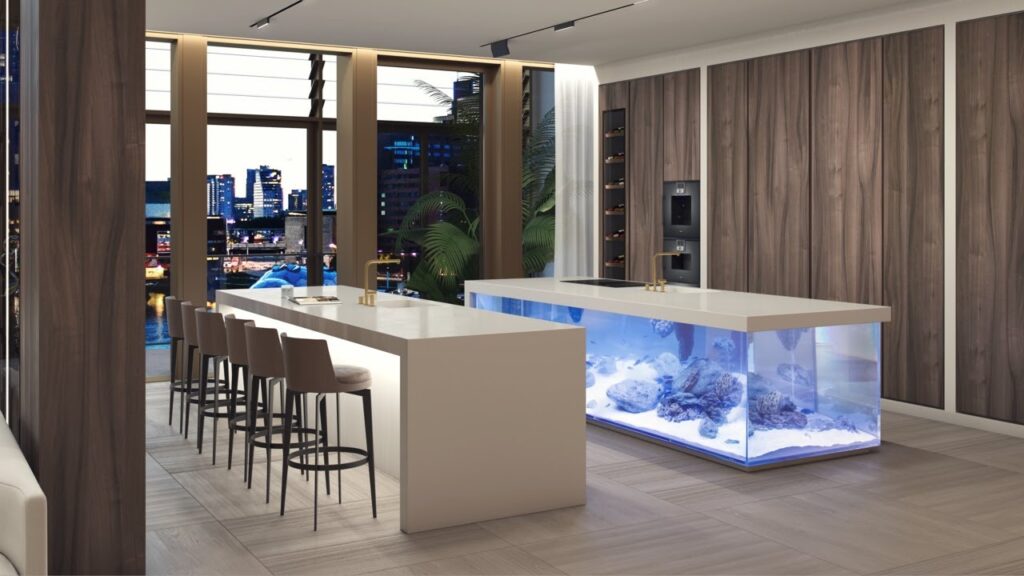To know how to design a kitchen island layout, start by defining the functions that you need the space to serve. Then consider the shape and size. Lighting and functionality are also crucial considerations. A designer will be able to help you get the desired results with years of experience. If you aren’t sure where to start, read on for a few tips. Here are some things to keep in mind while planning the layout of your new kitchen island.
Shape
There are many things to consider when deciding how to shape a kitchen island. Depending on the layout of your kitchen, a round or L-shaped island may be more functional, while a rectangular island may leave too much space unutilized. In the case of an L-shaped kitchen island, the space around the island is used for the kitchen while maintaining an open plan feel. Once you know how to shape a kitchen island, you will have no trouble building it.
The size of your kitchen island is important for two reasons: function and aesthetics. When designing your kitchen island, make sure to measure the area around it. Too large an island will not be functional, and too small an island will not allow for enough movement. When designing your kitchen island, use as much texture as possible to avoid the appearance of coldness and a cluttered countertop. Here are some examples of a good size kitchen island.
A large kitchen island can accommodate a sink. Be sure to choose a countertop with ample space for washing and drying dishes. Choosing a material that is easy to clean and tough is a great way to make your kitchen island functional and beautiful. You may even want a bar area if the space is big enough. Make sure the countertop is shaped in such a way that it doesn’t interfere with your work flow.
You can also design a kitchen island with shallow depth cupboards that are designed to accommodate a row of high stools. To avoid having to move it from one location to another, choose a countertop that extends down the sides of the island. The wrap-around effect is a great way to avoid an awkward and uncomfortable look. You can also consider an island seating idea that utilizes the perpendicular side of the kitchen island.
Size
The size of your kitchen island is crucial. Most kitchen islands are double counter depth, with at least three feet of floor space on both ends. An overhanging countertop can double as a dining table, so be sure to take this into account when choosing the size of your kitchen island. If you want a table with an overhanging countertop, you should consider having it at least 20 cm (8 inches) higher than the counter space. A higher island can also hide clutter and dirty dishes. A taller kitchen island will be ideal for open floor plans.
The ideal distance between the main kitchen worktop and the kitchen island is one meter (or 40 inches). This distance should allow two people to work efficiently in the space, with one person being able to walk behind the other while standing in front of the island. If you have a narrow space, one person might be unable to fully open all cabinets. It can also make the space feel cramped. So, be sure to consider the size of your island before choosing a design.
If you are unsure of the size of your kitchen, it is best to draw a floor plan so you can accurately determine the right size for the kitchen island. This way, you can see how the new kitchen island will fit into the space. Also, make sure to match the height of the chairs to the height of the island. Many islands are built with standard counter heights, so you’ll need chairs that are at least counter-height.
Function
A kitchen island is an excellent way to expand your counter space and provide additional seating and work surfaces. There are many different ways to design an island. You can include storage cabinets, seating, dishwashers and even microwaves. The most important part of a kitchen island design is determining its primary purpose and focus. The layout should enhance your workflow. Whether you plan to use your island for eating, preparing meals, or entertaining, it’s important to consider how your design will affect this area of your home.
To maximize the efficiency of your kitchen, place the island far enough away from the functional triangle – the path from the stove to the sink. This way, you won’t have to walk through your kitchen to use the refrigerator, sink, and stove. This is essential for efficiency. Additionally, if you’ve designed your kitchen as an open concept layout, it is best if the kitchen island doesn’t extend out into a seating area or another room.
If you want a more extravagant look, consider choosing a more expensive material for your kitchen island. Exotic hardwoods, deeply veined marble, or mottled granite can be a showpiece in a modern kitchen. Exotic timber veneers, burnished metal, and gleaming mirrored glass are all options that can make your kitchen island a real feature. Choosing a material that reflects your taste and personality can add to the beauty of your kitchen and increase the enjoyment of your time there.
In addition to size, you should also consider the shape of your kitchen island. A kitchen island doesn’t need to be large to make a statement. If you don’t have enough room to create a fully functional island, you can consider a peninsula-style layout. A peninsula-style island juts out from the wall, providing a similar function without the open space. You can also opt for a more traditional island layout if you don’t have the space for an island.
Lighting
The placement of island lighting can be tricky, especially when it doubles as a work surface or dining area. Choose rise and fall lights to add a versatile style that will accommodate any use. Light fittings for islands should be proportional to the size of the island and the space they will illuminate. If you have high ceilings, consider buying an oversized light fitting to fill the area. Alternatively, use two or three smaller pendants to accent the island.
While there are a number of ways to integrate lighting into the design of a kitchen island, the first and most crucial step is to choose the right kind of fixture for your space. A chandelier, pendant, or sconce can provide the proper ambience for an eat-in kitchen. A chandelier with a unique style can add a splash of glamour and color to the room. Other options are undercabinet fixtures that provide task lighting without taking up too much overhead visual space.
Besides providing adequate illumination, lighting for an island can also enhance the ambience and make it more social. For example, a stylish pendant light above a kitchen island can make the space feel more social and welcoming. Accent lighting with dimmers can also be a great option for kitchen islands. For an open concept space, you should choose a pendant light for the work area, while a recessed light for decorative purposes.
Choosing the correct lighting for your kitchen island is crucial to the overall design of the room. You can choose between three types of lighting: flush mount lighting, semi-flush mount, and recessed lights. Flush mount lighting is the most common and is perfect for homes with low ceilings. Semi-flush mount lighting, on the other hand, is also suspended from the ceiling, but it is slightly lower and hung a few inches lower. The advantage of semi-flush mount lighting is that you can place it almost anywhere in the kitchen.
Storage
There are many ways to incorporate storage into your kitchen island layout. A custom plate rack creates a stylish focal point, and beadboard painted in a complementary color provides a backdrop. Decorative panels and wood dowels also keep serving dishes in place. Measure items to make sure they’ll fit, and use pullout wire baskets beneath standard drawers to store your vegetables. You can also install an icemaker or microwave in a deeper nook.
You can use an island to serve as a dining area or extra work space. When choosing a layout for your island, consider its function. If it’s a place where you can eat meals, you should design it with seating and enough storage to accommodate a few stools. It should also be wide enough to hold items for preparing meals and serving guests. The shelves should not extend to the edge of the countertop, so you can keep food stored on top of them while still leaving enough room for serving.
When designing a kitchen island layout, consider how much storage you need. A kitchen island is a great place to install multiple storage options. One of Laura Burton Interiors’ design studios built multiple storage options into a custom kitchen island. The result is a functional space with a unique aesthetic appeal. With multiple storage options, you can maximize storage space without compromising on aesthetics. This is especially important if you’re working with limited space.
While kitchen islands should have a minimum size of four feet by two feet, they should be a good deal larger. For smaller kitchens, consider a simple table or mobile butcher block station. These options provide additional prep space and kitchen storage, but should not be the main workstation. Adding a table or mobile butcher block station to your island layout may be a great way to make more space available for other kitchen items.

